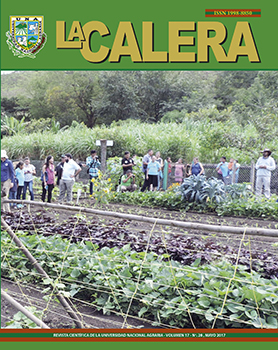Morphological characterization of local pig (Sus scrofa domesticus) in Nueva Guinea municipality, RACCS
DOI:
https://doi.org/10.5377/calera.v17i28.6365Keywords:
morphometric, phenotypic, biotypes, zoometric index, morphostructuralAbstract
The creole pig is a forgotten genetic resource, which at the moment is extremely threatened by the mestization of its genetic material with different specialized races. The present study was carried out with a total of 36 males and 57 females in the municipality of Nueva Guinea with the objective of characterizing the morphometric, phaneroptic, relationship of variables with sex and age and identifi cation of biotypes. Age and 12 morphological measures were determined, which were used to calculate 7 zoomometric indexes: cephalic (ICF), proportionality (IPD), body (ICP), chest depth (IPRP), thoracic (ITO), pelvic (IPV ), Thoracic metacarp (IMT), and phaneroptic characteristics in each individual. From the descriptive statistical analysis it was observed that the zoomometric measures evaluated reached a range of variation between 13.24% (LK) and 30.68% (DDE), reflecting that they are individuals with a high morphostructural variability. The regression analysis revealed that all body measurements are significantly related to age, but not with the variable sex that only presented positive relation with fi ve variables and in the total of the cases are not significant. With respect to zoomometric indexes, these pigs can be characterized as dolichocephalous (ICE = 42.51), longilineal (ICO = 98.75) and convexilineal (IPE), with a relatively deep trunk between the elliptic and cylindrical, reflecting values of coincident thoracic index With their condition of longils. In the phaneroptic characteristics, it is emphasized that these pigs predominate the layers and black mucous, body with abundant hair, absence of mamelles and syndactyly, with predominance of straight profiles. For the cluster analysis, four groups of animals were classified as having signifi cant differences between each of the morphometric variables evaluated. The results obtained allow us to know that they are individuals with high morphostructural variability and therefore it is diffi cult to do a zoomometric typing of the race, and on the other hand that the groups of individuals differentiated by cluster, even though they present statistically significant differences between the Different variables, cannot be considered as genetically differentiated biotypes, but rather a consequence of the environment, necessitating a treatment at a molecular level and not simply based on zootechnical measures.
Downloads
2286

